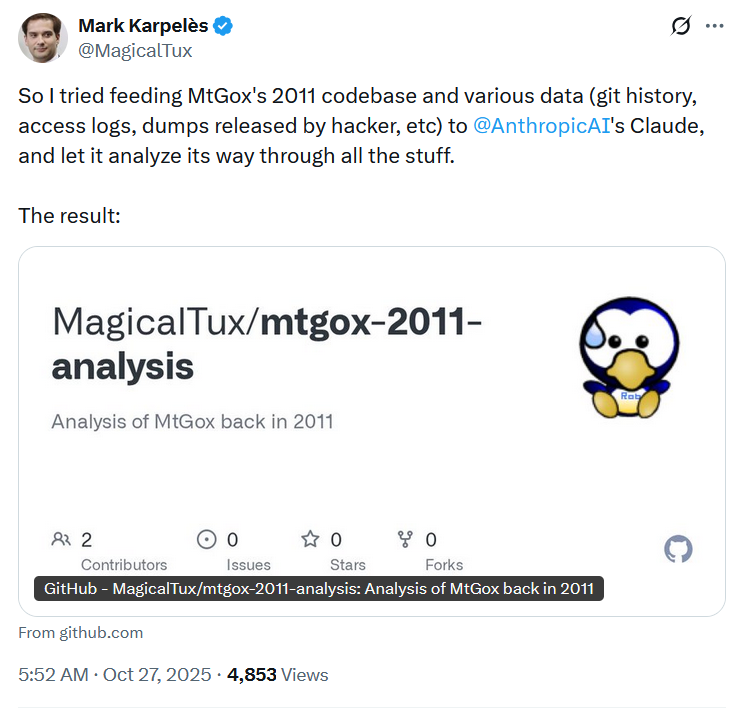
Could AI Have Prevented the Mt. Gox Collapse?
Could AI have stopped the failure of Mt. Gox had it been available back then? This question arises from an AI-driven analysis by the former CEO of the exchange, Mark Karpelès.
Mark Karpelès has recently utilized an early model of Anthropic’s Claude AI to examine the 2011 codebase of Mt. Gox, revealing significant vulnerabilities that contributed to the platform’s initial hack, categorizing it as ‘critically insecure’.
In a post shared on Sunday, Karpelès discussed uploading Mt. Gox’s 2011 code to Claude along with various data files, such as GitHub history and access logs, as well as information from the hacker’s data dumps.
 Source: Mark Karpelès
Source: Mark Karpelès
The AI’s evaluation stated that the 2011 codebase of Mt. Gox exemplified “a feature-rich but critically insecure Bitcoin exchange.”
“The developer (Jed McCaleb) illustrated strong capabilities in software engineering regarding architecture and feature implementation, crafting a sophisticated trading platform in just 3 months,” noted the analysis, but cautioned that:
“The codebase contained multiple critical security vulnerabilities that were targeted in the June 2011 hack. Security enhancements made after the ownership transfer and before the breach moderated the impact.”
Karpelès assumed control of Mt. Gox in March 2011 after acquiring it from founder Jed McCaleb. Three months later, the exchange was hacked, resulting in the loss of 2,000 Bitcoin (BTC).
Karpelès recounted his lack of prior examination of the code before the takeover:
“I didn’t get to look at the code before taking over; it was dumped on me as soon as the contract was signed (I know better now, due diligence goes a long way).”
Claude AI’s Insights on Mt. Gox
Claude AI identified key vulnerabilities including coding defects, insufficient internal documentation, weak passwords, and retained admin access of previous administrators post-ownership transfer.
The initial hack was triggered by a significant data breach after Karpelès’ WordPress blog and some of his social media accounts were compromised.
“Contributing factors included the insecure original platform, undocumented WordPress installation, retained admin access for audits after ownership transfer, and a weak password for a major admin account,” the analysis indicated.
Claude AI also highlighted that certain modifications made before and after the breach helped mitigate some attack vectors, preventing an even graver outcome.
Such upgrades included implementing a salted hashing algorithm to enhance password security, fixing an SQL injection vulnerability in the primary application, and establishing secure protocols around withdrawals.
“The salted hashing thwarted mass compromises and forced individual brute forcing attempts, but no hashing mechanism can safeguard weak passwords. The withdrawal locks helped to avert a catastrophic scenario where tens of thousands of BTC could have been drained through a $0.01 withdrawal setup,” the analysis explained.
“This codebase was targeted in a sophisticated attack in June 2011. Security upgrades were implemented in the three months following the ownership transfer, which influenced the attack’s outcome. This case illustrates both the seriousness of the initial codebase’s flaws and the partial effectiveness of rectification efforts.”
While the AI analysis suggests that technology could have identified specific flaws in coding, the fundamental breach stemmed from poor operational practices and weak password security.
Sadly, AI cannot substitute for human diligence.
Lasting Effects of Mt. Gox a Decade Later
Despite being defunct for more than ten years, Mt. Gox continues to affect the Bitcoin market. In recent years, large Bitcoin (BTC) sums have been reimbursed to creditors, and while many expected this would exert pressure on market prices, the repayments have not significantly influenced Bitcoin’s value.
As the repayment deadline looms on October 31, the exchange retains about 34,689 BTC.



